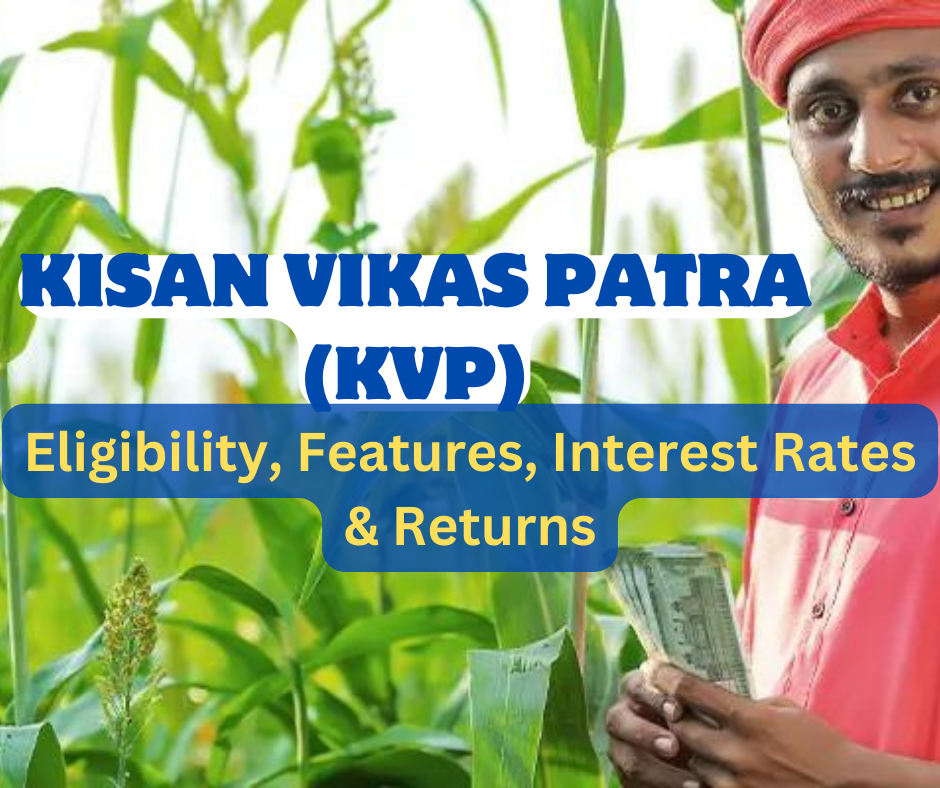
Table of Contents
Kisan Vikas Patra
Kisan Vikas Patra, often abbreviated as KVP, is a savings certificate program offered by the Indian post office. It’s a unique investment scheme that can double your money in around 9.5 years, or 115 months. For instance, if you invest Rs. 5,000 in a Kisan Vikas Patra, it will grow to Rs. 10,000 after it matures. In this article, we’ll dive into the key features and potential benefits of this scheme.
What is Kisan Vikas Patra?
The India Post introduced the Kisan Vikas Patra in 1988 as a small savings certificate scheme. Its primary goal is to promote long-term financial discipline among people. The tenure for the scheme is currently set at 115 months, equivalent to 9 years and 5 months.
To get started, you need to invest a minimum of Rs. 1,000, and there’s no upper limit on the investment amount. The unique aspect of KVP is that your investment doubles upon maturity. Initially designed for farmers to save for the long term, it’s now available for all.
To ensure transparency and prevent money laundering, the government made it mandatory in 2014 to provide a PAN card for investments above Rs. 50,000. For deposits of Rs. 10 lakhs and above, you’ll need to submit income proofs like salary slips, bank statements, and ITR documents. It’s also essential to provide your Aadhaar number as proof of your identity.
Types of Certificates Available
Kisan Vikas Patra certificates come in different types:
- Single Holder Type Certificate: Issued to an adult for themselves or on behalf of a minor or to a minor.
- Joint ‘A’ Type Certificate: Issued jointly to two adults, payable to both holders jointly or to the survivor.
- Joint ‘B’ Type Certificate: Issued jointly to two adults, payable to either of the holders or to the survivor.
KVP Eligibility
To invest in Kisan Vikas Patra, you need to meet the following criteria:
– You must be an Indian citizen.
– You must be above 18 years of age.
– An adult can apply on behalf of a minor or a person of unsound mind.
– Hindu Undivided Family (HUF) and Non-Resident Indians (NRIs) are not eligible to invest in KVP.
Who Should Invest in the KVP Scheme?
Any Indian citizen aged 18 or above can purchase a Kisan Vikas Patra from the nearest post office. This scheme is particularly attractive to people in rural areas who may not have access to a bank account. You can also buy a KVP for a minor or jointly with another adult, provided you specify the minor’s date of birth and the name of the parent or guardian. A trust can also invest in KVP, but HUFs and NRIs are not eligible.
KVP is an excellent choice for risk-averse individuals with surplus funds they won’t need in the near future. Your choice should align with your financial goals and risk tolerance. If you’re looking for tax-saving options, other investments like the Public Provident Fund, National Saving Certificates, and tax-saving bank FD schemes might be more suitable. For those willing to take on some risk, there’s the Equity Linked Savings Scheme (ELSS). So, tailor your investment to your financial circumstances.
Features and Benefits of Kisan Vikas Patra
- Guaranteed Returns: KVP offers assured returns regardless of market fluctuations, making it an ideal choice for those seeking stability and security in their investments.
- Capital Protection: Your investment is safe from market risks, and you’ll receive both your principal amount and gains at the end of the tenure.
- Interest: The effective interest rate for Kisan Vikas Patra varies depending on the number of years you invest in KVP at the time of purchase. As of Q2 FY 2023-24, the interest rate is 7.5% per annum, compounded yearly. Compounded interest means you’ll receive higher returns on your deposit.
- Maturity: KVP matures after 115 months, and your accumulated interest continues to grow until you withdraw the amount.
- Taxation: KVP doesn’t offer 80C deductions, and the returns are fully taxable. However, Tax Deducted at Source (TDS) is exempt for withdrawals after the maturity period.
- Rules for Premature Withdrawal: Although the account matures after 115 months, there’s a lock-in period of 30 months (2 years and 6 months). Premature withdrawal is only allowed in the event of the account holder’s demise or by a court order.
- Ease and Affordability: KVP certificates are available in denominations of Rs. 1,000, Rs. 5,000, Rs. 10,000, and Rs. 50,000 for investment, with no maximum limit. Note that denominations of Rs. 50,000 are only available at the head post office of a city.
- Loan against KVP Certificate: You can use your KVP certificate as collateral to secure loans, often at lower interest rates compared to other forms of borrowing.
- Nomination Facility: You can nominate a beneficiary by filling out a nomination form available at the post office. If you’re nominating a minor, include their date of birth.
KVP Certificate Issuance & KVP Identity Slip
KVP certificates are issued on the spot if you make a cash payment. If you pay by cheque, demand draft, or money order, you’ll receive the certificate once the amount clears at the post office.
KVP Identity Slip includes the Kisan Vikas Patra Certificate, the KVP serial number, the investment amount, the maturity date, and the amount you’ll receive upon maturity.
Steps to Invest in Kisan Vikas Patra and Required Documents
Investing in Kisan Vikas Patra is straightforward. Here’s what you need to do:
- Collect the application form, Form A, and fill it out with the necessary information.
- Submit the duly filled form to the post office or bank.
- If you’re investing in KVP through an agent, the agent should fill out Form A1. You can also download these forms online.
- The Know Your Customer (KYC) process is mandatory, so be prepared to submit a copy of your ID and address proof, which can include PAN, Aadhaar, Voter’s ID, Driver’s License, or Passport.
- Once your documents are verified, make the deposit, which can be done using cash, locally executed cheque, pay order, or demand draft payable to the postmaster.
- You’ll receive a KVP certificate immediately, except when you make the payment by cheque, pay order, or demand draft. Keep this certificate safe, as you’ll need it at the time of maturity. You can also request to have the certificate sent to you via email.
In summary, if Kisan Vikas Patra aligns with your financial goals, it’s a hassle-free investment option that’s easy to open and manage. All you need to do is have the required amount ready and visit your nearest post office.
You can also read about Atal Pension Yojana (APY) on the official website n the link: Atal Pension Yojana
Frequently Asked Questions (FAQs)
Q1: Can I transfer my KVP from the post office to the bank?
A1: Yes, you can transfer your KVP certificate from the post office or bank to another post office or bank by submitting an application using Form B. This can be done at your post office or bank, and the application must be signed by the holder or holders, except in the case of Joint ‘A’ type certificates where one of the joint holders can sign the application if the other is deceased.
Q2: How long does it take for KVP to double?
A2: Your investment in KVP will double in 115 months, which equals 9 years and 5 months.
Q3: Is KVP subject to taxation?
A3: KVP doesn’t offer 80C deductions, so the returns are fully taxable. However, withdrawals made after the scheme matures are exempt from Tax Deducted at Source (TDS).
Q4: How can I cash in my KVP after it matures?
A4: Upon maturity, the payable amount will be credited directly to the bank or post office savings account of the certificate holder. Therefore, you can cash in your KVP at the same post office or bank where it was issued. You’ll need to present the identity slip provided at the time of issue when encashing.
Q5: Can I cash in my KVP at a different Post Office if I’ve moved to a different city?
A5: You can encash your KVP at any Post Office if your identity slip is accepted and it’s confirmed by the Post Office that you initiated the KVP. Ideally, it’s more convenient to encash it at the Post Office of issue.
Q6: What happens if I don’t cash in my KVP after it matures?
A6: If the KVP certificate isn’t encashed after maturity, you’ll be entitled to post office savings interest at the rate applicable on the entire maturity amount at that time. If you encash the certificate within a month after maturity, no interest will be paid.”
You can also read:


5 thoughts on “Kisan Vikas Patra (KVP): Eligibility, Features, Interest Rates & Returns”